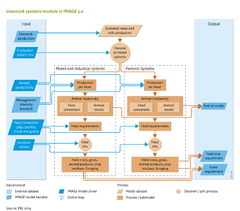Livestock systems/Policy issues: Difference between revisions
Jump to navigation
Jump to search
No edit summary |
m (Text replace - "Roads from Rio+20 (2012)" to "Roads from Rio+20 (2012) project") |
||
| Line 1: | Line 1: | ||
{{ComponentPolicyIssueTemplate | {{ComponentPolicyIssueTemplate | ||
|Description=Global grass consumption has increased by more than 40% between 1970 and 2010 (see figure below), and global grassland area has slowly increased from 3134 to 3313 million hectares (about 5%) between 1970 and 2010 (see the figure in the policy intervention example section). The global area of extensively used pastoral grassland and mixed systems shows slight and gradual changes. Production characteristics of extensive pastoral production systems have not changed much, whereas those of mixed and industrial systems have been changing rapidly, with trends towards intensification. For the future, most baseline scenarios indicate that, in the coming decades, a similar increase in grass production is required as observed historically. Under the baseline scenario from the [[Roads from Rio+20 (2012) |Rio+20]] study, these developments result in a slow increase of 2% in global grassland area (see figure below). This slower increase than observed historically is mostly caused by a slower growth in consumption. | |Description=Global grass consumption has increased by more than 40% between 1970 and 2010 (see figure below), and global grassland area has slowly increased from 3134 to 3313 million hectares (about 5%) between 1970 and 2010 (see the figure in the policy intervention example section). The global area of extensively used pastoral grassland and mixed systems shows slight and gradual changes. Production characteristics of extensive pastoral production systems have not changed much, whereas those of mixed and industrial systems have been changing rapidly, with trends towards intensification. For the future, most baseline scenarios indicate that, in the coming decades, a similar increase in grass production is required as observed historically. Under the baseline scenario from the [[Roads from Rio+20 (2012) project |Rio+20]] study, these developments result in a slow increase of 2% in global grassland area (see figure below). This slower increase than observed historically is mostly caused by a slower growth in consumption. | ||
Several different economic developments and policy interventions mat change the baseline trend. For example, an increasing demand for ruminant meat may increase the required amount of grassland. Climate change may change grassland productivity, which will also have its effect on the grassland area that is required. | Several different economic developments and policy interventions mat change the baseline trend. For example, an increasing demand for ruminant meat may increase the required amount of grassland. Climate change may change grassland productivity, which will also have its effect on the grassland area that is required. | ||
In addition, several characteristics of production systems may change grassland development. | In addition, several characteristics of production systems may change grassland development. | ||
Revision as of 15:46, 13 January 2014
Parts of Livestock systems/Policy issues
| Component is implemented in: |
| Components: |
| Related IMAGE components |
| Projects/Applications |
|
| Models/Databases |
| Key publications |
